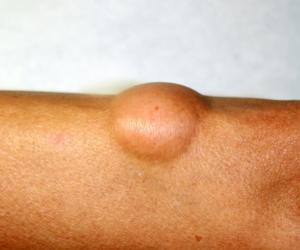What Is a Pleomorphic Adenoma: Is It Dangerous?

Introduction
The salivary glands produce saliva, which keeps the mouth moist, helps digest the food, and prevents the rapid decay of our teeth. The salivary glands are small in size and are located around the inner lining of the mouth, cheeks, and lips. Many diseases from cancerous tumors to Sjogren’s syndrome may affect the salivary glands. Some may go away with antibiotics while some may require surgery.
Pleomorphic adenoma and Warthin's tumor are non-cancerous tumors that commonly affect the parotid glands. Pleomorphic adenomas may also affect the minor salivary glands and submandibular gland. Although this condition happens very rarely, these tumors might become malignant and life-threatening. Hence, their treatment is important to prevent the development of a malignant tumor.
What is pleomorphic adenoma?
A pleomorphic adenoma is also known as a benign mixed tumor. It is a non-cancerous or benign tumor that commonly occurs in the salivary gland. Pleomorphic adenoma can occur in all ages and both genders. However, the condition is more prevalent in women who are 30-60 years old.
Its morphological variability is depicted by the name itself. The epithelial, myoepithelial, mesenchymal components and salivary contractile tissues determine its diverse presentation. The epithelial cells are characterized by polygon-like squamous presentation while the spindle-shaped are myoepithelial cells. The stromal or mesenchymal component shows a mucoid cartilaginous neoplasm.
The condition may occur in any area of the salivary gland. However, it most commonly affects the parotid gland. The tumor usually grows in the palatine process and lips. It commonly displays a single and well-defined growth.
Pleomorphic adenoma exhibits a diverse architecture along with a wide cytomorphology. The tumor has three components, which include:
- A myoepithelial cell component
- A stromal component
- An epithelial cell component
To recognize pleomorphic adenoma from other types of tumors, identifying these three components is necessary. Its identification may quantitatively vary.
Signs and Symptoms
- A tumor mass on the cheek, in the mouth, or around the jaw, and usually affects the hard and soft palate.
- Most of the tumors are coated by a capsule. These masses are mobile, smooth, and firm.
- They are usually solitary. However, there can also be multiple lesions that come from the same gland or other salivary glands.
- Tumors are often oval, spherical, and well-defined.
- The growth is usually painless unless the structures that surround it are compressed.
- Around 80 percent of the tumors are confined to the parotid gland. Nearly 10 percent of the cases affect the submandibular gland. Intraoral pleomorphic adenoma happens when a tumor affects the minor salivary gland.
In the case of large tumors, the following symptoms may be experienced:
- Facial numbness or pain
- Chewing difficulties
- Dry mouth
- Breathing problems
- Facial nerve paralysis due to nerve damage
Pleomorphic adenoma develops as a lesion, which can slowly grow over the years. Manifestations usually occur depending on the primary location of the proliferating lesion.
Other symptoms include:
- Airway obstruction
- Lump in the throat
- Hoarseness
- Breathing disturbances
- Dysphasia
- Difficulty swallowing
- Epistaxis, sinusitis, and nasal obstruction
- Weakness and facial paralysis due to facial nerve compression in larger parotid tumors
Since the ducts of the salivary gland may get blocked, it can lead to long-term growth. If the duct is partially blocked, then the patient may experience swelling and discomfort, especially after eating meals. If the duct is completely obstructed, then extensive pain is felt. If the tumor extends to the adjacent tissues, it may transform into a malignant tumor.
Epidemiology
Pleomorphic adenoma is the most common salivary gland tumor in children and adults. Around 45-70 percent of salivary gland neoplasms are represented by this condition. Each year, pleomorphic adenoma affects 2-3.5 out of 100,000 individuals. Even though the condition can occur in all ages, it is more commonly observed in people who are 30-60 years old. It is also seen more often in women than men with a ratio of 2:1.
Etiology
Although the etiology is still unknown, its incidence increases 15-20 years after radiation exposure. According to one study, the simian virus may play a significant role when it comes to pleomorphic adenoma development.
Location
Around 70-80 percent of pleomorphic adenoma occur in the superficial lobe of the parotid gland, although the lesion may occur in any area of the parotid gland. Pleomorphic adenoma is less commonly seen in the submandibular salivary gland and is seldom observed in the sublingual gland.
The most common sites of pleomorphic adenoma are the palate, lip, and minor salivary glands. However, the nose, larynx, and paranasal sinuses could also be involved. Unusual or rare sites could include ectopic salivary gland tissues.
Clinical Features
The signs and symptoms usually depend on the tumor's location. Pleomorphic adenoma often presents a painless slow-growing mass, which may have existed for many years.
Although seldom encountered, individuals with a parotid gland tumor may experience weakness of the facial nerve. However, facial nerve weakness is likely to increase if the tumor is left unchecked and has become large due to malignant change.
Individuals with minor salivary gland tumors may experience various symptoms, which also depend on the tumor's location. The symptoms may include hoarseness, chewing problems, and epistaxis.
Gross Findings
Pleomorphic adenoma on gross examination presents a single, well-circumscribed mobile mass. It can be as small as a few millimeters or can be large or giant. It may be whitish-tan, grayish, or bluish in color. Its shape is irregular and its surface is often bosselated.
On sectioning, degenerative and cystic changes can be seen. Focal or massive infarction can be observed as evidence. Multiple nodules of variable size are a characteristic presentation of recurrent tumors.
Predictive Factors and Prognosis
Prognosis after surgical resection is excellent in patients with benign well-circumscribed tumors. However, when a pleomorphic adenoma is in the parotid gland, recurrence can be a problem. Many factors have been related to its recurrence, which includes an incomplete capsule, tumor nodule extensions beyond the capsule, and intraoperative rupture of a tumor, wherein the contents of the tumor are spilled into the operative field.
Tumors with high mesenchymal content have been also associated with recurrence. In 2-7 percent of cases, malignant changes might occur and are associated with deep lobe tumors, older age, male gender, and multiple recurrences. The cell morphology of a malignant tumor can be indistinguishable from its benign counterpart. Thus, malignant tumors can be presumed as benign tumors sometimes.
Causes
The primary cause of pleomorphic adenoma is a blockage in the salivary duct, which inhibits the draining of the saliva. The condition has also been associated with harmful radiation exposure and tobacco smoking. The continuous or prolonged use of mobile phones may also be associated with neoplasm development according to some studies, although such claims still remain unverified.
Diagnosis
The doctor will first ask about your specific symptoms and medical history. Next, the doctor will conduct a physical examination. If any abnormal growth is suspected, then the doctor would suggest certain diagnostic tests and tissue sampling. The doctor might order the following tests:
- Imaging Scans - These scans are used to look for tumors or stones. Imaging scans include an X-ray, MRI scan, or a CT scan.
- Fine Needle Aspiration (FNA) Biopsy - It involves a small gauge needle, which is used along with an ultrasound. The procedure enables sample aspiration with 90 percent sensitivity. Moreover, FNA helps when it comes to differentiating benign from malignant tumors. In a core needle biopsy (CNB), a larger needle is used.
- Sialography - It is another type of radiographic examination. It usually involves the injection of a special dye or contrast medium into the salivary gland followed by an X-ray to identify problems in the salivary duct.
- Tests for Sjogren's Syndrome - It includes salivary gland function tests, eye tests, and certain blood tests.
Treatment
Radiation therapy is recommended in certain cases. Recurrence can be prevented by this treatment. It can also suppress the cellular activity of the mass. Some of its common side effects are:
- Xerostomia or dry in the mouth
- Oral mucositis
- Mouth inflammation
Chemotherapy cannot be used, unlike in cancer. The protocol for the use of chemotherapy drugs in salivary tumors has not been established yet.
Radiotherapy
Follow-up radiation is necessary in some cases. However, it is not recommended by the National Institutes of Health (NIH). It suggests that radiation therapy is not required in most cases and that it is reserved only for specific patients since the likelihood of recurrence and malignancy may increase due to radiation therapy. The recurrence rate of patients with benign pleomorphic adenoma is around 6-7 percent.
Surgery
The surgical resection of the affected salivary gland is the mainstream management of pleomorphic adenoma. Complete excision or removal of the gland is recommended in the case of submandibular, sublingual, and minor salivary gland tumors.
Laterally located to the facial nerve is the superficial portion of the gland of which surgical resection is done. In some cases where chances of recurrence are high, the entire parotid gland is removed and total parotidectomy is done. This is also done to prevent exacerbation.
If there is an involvement of the regional lymph nodule, neck dissection may be necessary to remove the growth. Surgical procedures may sometimes give rise to certain complications when adjacent nerves are severely damaged. If the facial nerve is injured, it might cause facial paralysis. Hypoglossal and lingual nerve damage could result in paralysis of the tongue.
Frey's syndrome may occur if the autonomic pathway is disturbed in the area of the post-parotid surgery procedure. The manifestations of this condition are red cheeks and sweating, which are abnormal. This condition might be triggered by perceiving or eating food that induces salivation.
Complications
Pleomorphic adenoma of the salivary gland may cause further complications. They include:
- Cosmetic concerns
- Severe emotional stress
- Multiple tiny nodules around the main mass
- Recurring tumor after surgery (rare)
- Malignant tumors over a period of 10-15 years
- Facial nerve palsy and wound infection after surgery
Prevention
A method to prevent the formation of pleomorphic adenoma has not been established yet. Blood tests, physical examination, radiological scans, and regular screening would be helpful for those who have already endured the tumor.













